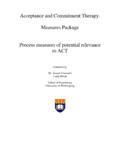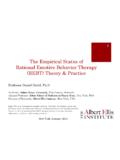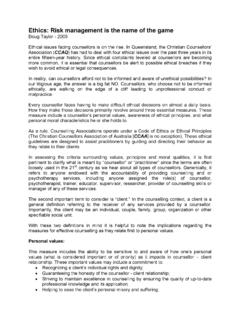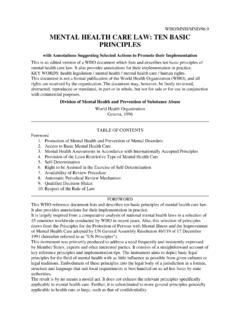Transcription of California Sex Offender Management Board - …
1 California California California Sex Offender Management Sex Offender Management Sex Offender Management BoardBoardBoard Sex Offender TreatmentSex Offender TreatmentSex Offender Treatment TrainingTrainingTraining RequirementsRequirementsRequirements August 2013 August 2013 August 2013 CASOMB Certification and Re-certification Requirements for Sex Offender Treatment Providers (Revised July, 2013) The goal of regulating initial and ongoing training for professionals who are expected to provide effective treatment services to registered sex offenders is the development and maintenance of a pool of certified practitioners who are solidly grounded in the core elements of sex Offender treatment and who bring a breadth of expertise to their work. Providing a list of training topic areas which are seen as important for developing and maintaining the expertise of Certified providers is one element in CASOMB s attempt to achieve that goal.
2 It has become apparent that the training requirements need to be set forth in a way which ensures a broad base of expertise and, therefore, in a way which ensures that not all the required training for any provider be obtained by focusing narrowly on just one or two topics. The training requirement structure established by CASOMB requires that the training hours not all be concentrated only in one area of focus. The changes to the training requirements have three major features. 1. The list of acceptable core and adjunct topics has been expanded. 2. The core topics have been grouped into six Domains. 3. In order to promote a broad base of training, limits have been set on the number of hours of core training from any specific Domain which can be counted toward the certification or re-certification requirements.
3 CASOMB acknowledges that it is difficult to build reasonable regulations which absolutely insure the desired breadth of training. However, the spirit of training for certification requires professionals to select training opportunities which continually broaden their expertise and scope of practice rather than to repeatedly seek training in just a few restricted areas. In approving training hours submitted for certification, CASOMB will expect compliance with the spirit of the regulations and not simply with observation of the letter of the law when it comes to the selection of training areas. The present revision of the structures and topics for core and adjunct trainings was published on the CASOMB website on August 7, 2013. After January 1, 2014, all new applicants will be expected to comply with these revised requirements.
4 These new requirements will also be in effect for all re-certifications, which will occur, beginning in July, 2014, on each Certified provider s birthday month. Training Requirements for each Certification Level Independent Practitioner 1. An individual seeking certification or re-certification at the Independent Practitioner level must, over the previous two years, complete a minimum of 30 hours of training from the topic areas listed below. 2. 20 hours of this training must be from the core topic Domains. 3. No more than 16 hours of this core topic training can be counted from any single specific Domain. Associate Practitioner 1. An individual seeking certification or re-certification at the Associate Practitioner level must, over the previous two years, complete a minimum of 20 hours of training from the topic areas listed below.
5 2. 15 hours of this training must be from the core topic Domains. 3. No more than 12 hours of this core topic training can be counted from any single specific Domain. Apprentice Practitioner 1. An individual seeking certification or re-certification at the Apprentice Practitioner level must, over the previous two years, complete a minimum of 8 hours of training from the topic areas listed below. 2. All 8 hours of training must be from the core topic Domains. 3. All 8 hours may be from one single Domain or may be from any combination of the core Domains. CASOMB-APPROVED TRAINING TOPICS A. Core Training Topics The topic areas listed below are seen by CASOMB as representing central training areas for those who provide assessment, treatment and Management to sex offenders. # TOPICS DOMAIN ONE SEX Offender CHARACTERISTICS AND DYNAMICS 1 Empirical data on sex offense and victimization demographics, etiology, epidemiology, and Offender recidivism 2 Sex Offender or sex offense characteristics and typologies 3 Cycles, patterns, and pathways leading to sexual abuse 4 Thinking errors or cognitive distortions used by sex offenders 5 Adverse Childhood Experiences as related to sex offending 6 Neurobiological and neurodevelopmental factors associated with sex offenders 7 Special sex Offender populations such as: female offenders, psychopathic offenders, intellectually and developmentally disabled offenders, chronically mentally ill offenders, child pornography offenders 8 Special issues in sex Offender populations such as.
6 Traumatic brain injury, physical disabilities, learning disabilities, or borderline intellectual functioning DOMAIN TWO SEX Offender ASSESSMENT 1 Sex Offender assessment procedures 2 Sex Offender risk assessment tools certified by SARATSO (Currently Static 99-R, LS/CMI, SRA-FVL and JSORRAT-II) 3 Other validated risk assessment tools such as the Hare PCL-R, HCR 20, MnSOST-3, SOTIPS, SORAG, Stable 2007 and SVR-20 4 Assessment of special sex Offender populations: female offenders, psychopathic offenders, intellectually and developmentally disabled offenders, chronically mentally ill offenders, child pornography offenders 5 Measurement of sexual deviance using penile plethysmography or viewing measures 6 Assessment and diagnosis of paraphilias DOMAIN THREE SEX Offender TREATMENT 1 Evidence based and promising best practice sex Offender treatment techniques including cognitive behavioral, relapse prevention, self-regulation, and Good Lives model interventions 2 Risk, needs.
7 And responsivity principles applied to sex Offender treatment 3 Strategies or methods to identify and target sexual and non-sexual criminogenic factors in sex Offender treatment 4 Assessment based sex Offender treatment planning 5 Approaches to evaluating and reducing denial and resistance in sex offenders 6 Group therapy dynamics specific to sex offenders 7 Pharmacotherapy with sex offenders DOMAIN FOUR HUMAN SEXUALITY RELATED TO SEX Offender DYNAMICS 1 Behavioral treatment techniques used with sex offenders 2 Understanding deviant sexual arousal or paraphilias 3 Etiology and development of deviant sexual fantasies 4 Utilization of techniques to reduce deviant sexual arousal 5 Healthy sexuality training for individuals who have sexually offended 6 Cultural issues related to sexual abuse and to the assessment and treatment of sex offenders 7 The role of pornography, including child pornography, in sexual offending DOMAIN FIVE SEX Offender Management 1 Legal and ethical issues regarding sex offenders and sex Offender treatment 2 Sex Offender law, policy, and Management practices 3 Theory, implementation and use of the Containment Model 4 Use of polygraphy in the context of containment and treatment 5 Training in providing clinical supervision and consultation to clinicians working with sex offenders 6 Sex Offender registration requirements 7 Utilization of chaperones, companions, and Circles of Support and Accountability 8 Issues in family resolution or reunification 9 Instruction regarding CASOMB certification and other CASOMB-related topics 10 SARATSO risk assessment scoring certification DOMAIN SIX CORE TOPICS NOT SPECIFICALLY RELATED TO SEX OFFENDERS (Note.)
8 A maximum of eight hours in this domain may be counted toward core topic requirements; any additional hours in this domain may be included in adjunct topic hours) 1 Transtheoretical Stages of Change Model and its application 2 Motivational Interviewing (MI) and related skills 3 Psychopathy 4 Program evaluation: program monitoring, program fidelity and program drift 5 Cognitive Behavioral Therapy (CBT) 6 Group therapy: group dynamics and effective group facilitation B. Adjunct Training Topics The topic areas listed below are seen by CASOMB as representing relevant and helpful but not central training areas for those who provide assessment, treatment and Management to sex offenders. 1 California child, dependent adult, and elder abuse reporting requirements 2 Sexual compulsivity and addiction as applied to sex offenders 3 Issues related to pornography production and consumption 4 Issues related to human trafficking and prostitution 5 Empathy training 6 Victim Issues such as the effects of victimization 7 Impact of sex offenses on society 8 Methods for the assessment of treatment progress 9 Secondary and vicarious trauma in treatment providers 10 Therapist wellness and self-care 11 Anger Management interventions 12 Alcohol and other drug abuse assessment and treatment with sex offenders 13 Human sexuality 14 Supervision techniques with sex offenders 15 Psycho-educational theory and effective application 16 Acceptance and Commitment Therapy (ACT) 17 Dialectic Behavior Therapy (DBT)
9 18 Attachment and relationally-based treatment 19 Psychology of men and approaches to correctional treatment with males; 20 Strategies for working with involuntary clients 21 Global Positioning Satellite (GPS) technologies and applications 22 Assessment of readiness for treatment and development of corresponding interventions 23 Documentation and report writing 24 The role in sex offending of psychiatric disorders such as Anti-Social Personality Disorder (ASPD); Bi-Polar Disorder; Attention Deficit Hyperactivity Disorder (ADHD); Post Traumatic Stress Disorder (PTSD) [Or equivalent diagnoses in DSM V or ICD-9 or 10] 25 Other topic areas which have not been specifically named but which have a clear and demonstrable relevance for sex Offender assessment and treatment. Any such training topic not specifically named above must receive PRIOR approval from CASOMB in order to be accepted.
10 Contact CASOMB staff.














